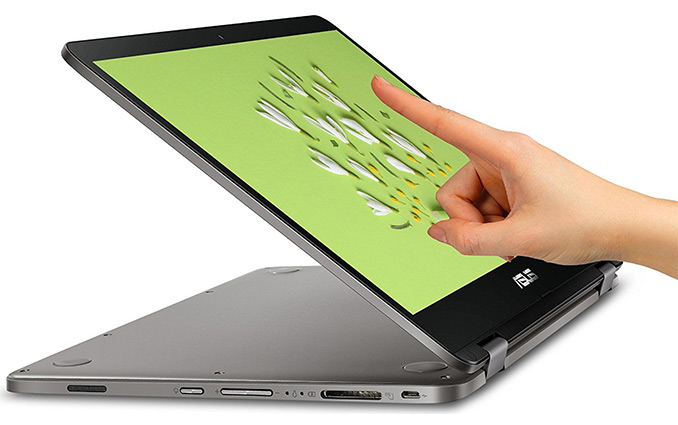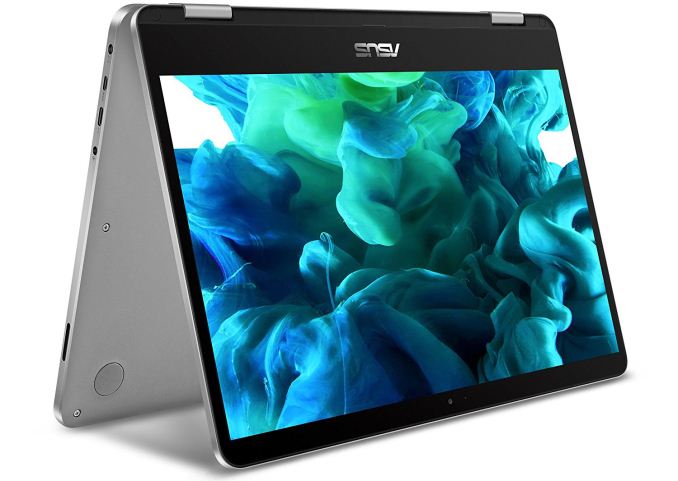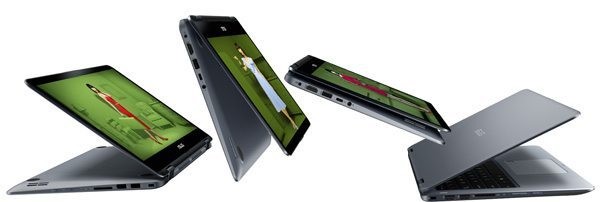ASUS VivoBook Flip 14 TP401 Convertible Launched: $549 with Core m3
by Anton Shilov on October 23, 2017 11:00 AM EST
ASUS has started to sell its new entry-level convertible laptop, based on an Intel 7th generation Core m3 processor (Kaby Lake-Y) SoC. Convertable in this case means the rotation of the hinge, allowing the notebook to 'convert' into a tablet. The combination of a relatively affordable price point ($549) with a very energy-efficient Core-based processor has a potential to make the VivoBook Flip 14 TP401 popular among customers with budget constraints seeking for a hybrid mobile PC.
Convertibles are believed to be a growing category, on the otherwise declining PC market, because many people want to use their devices both as laptops and as tablets. Historically, large computer suppliers positioned convertibles as higher-end machines worth a premium and charged accordingly. Last year Intel proposed to use its low-cost/low-power Atom platform for convertibles to make them cheaper but without compromising battery life. Since then, a number of companies have introduced appropriate products to address the entry-level segment of the market. At the same time, PC makers are trying to lower costs of convertibles based on Intel’s high-performance Core microarchitecture to address the mainstream segment and traditional customers who buy $500 - $700 PCs. Earlier this year Acer introduced its Switch 3 detachable machine based on a Kaby Lake Celeron SoCs, and that device started at $399. Now, ASUS has started to sell its VivoBook Flip 14 TP401 that features a higher-performance SoC, but serves the same purpose: introduces Intel’s high-performance microarchitecture to an inexpensive convertible laptop.
The ASUS VivoBook Flip TP401 is 14” hybrid notebook based on Intel’s Core m3-7Y30 SoC with up to 4.5 W TDP. The model in question (TP401CA-DHM6T) is equipped with 4 GB of LPDDR3 memory as well as a 128 GB eMMC storage solution. For connectivity, the convertible uses an 802.11ac Wi-Fi + BT 4.1 wireless module, has one USB 3.0 Type-C port, one Micro USB 2.0 port, a micro-HDMI display output, a 3.5mm TRRS audio jack, an SDXC card reader and so on.
Unlike many entry-level systems, the ASUS VivoBook Flip TP401 comes in an enclosure made of an aluminum alloy that gives a feel of a premium product. This premium feeling is somewhat spoiled by the screen resolution (1366×768 pixels) that seems to be low by modern standards, but it does have wide viewing angles suggesting this is a reasonable panel (i.e. not TN). The 360° multi-gear hinges are made of stainless steel and can handle 20,000 open-and-close cycles, according to the manufacturer. The hinges support notebook mode, tablet mode, 'tent' mode, and an 'entertainment' mode.
As for physical dimensions and weight, the VivoBook Flip TP401 is 15.4 mm thick and weighs around 1.5 kilograms, which is slightly thicker and heavier when compared to higher-end laptops, but is good enough considering the price of this convertible and its screen size. For some reason, ASUS does not specify for how long the unit can work on one battery charge, but only says that the TP401CA-DHM6T comes with a 39 Wh accumulator and "lasts for a day".
| ASUS VivoBook Flip 14 TP401 Convertible | ||||
| TP401CA-DHM6T | ||||
| Display | Resolution | 1366×768 | ||
| Panel | 14" 178° viewing angles |
|||
| SoC | Intel Core m3-7Y30 2C/4T 1.0 GHz base 2.6 GHz turbo 4 MB LLC 4.5W Intel HD 615 |
|||
| RAM | 4 GB LPDDR3 | |||
| Storage | 128 GB eMMC | |||
| Camera | VGA webcam | |||
| Wireless | 802.11ac Wi-Fi Bluetooth 4.1 |
|||
| I/O ports | 1 × USB 3.0 Type-C 1 × Micro-USB 2.0 1 × SDXC Card reader 1 × micro HDMI |
|||
| Audio | 2 × Speakers w/ ASUS SonicMaster 1 × TRRS 3.5-mm jack for headset |
|||
| Dimensions | Width | 327.4 mm / 12.89" | ||
| Depth | 226.5 mm / 8.92" | |||
| Height | 15.4 mm / 0.61" | |||
| Weight | ~1.5 Kg / 3.3 lbs | |||
| Battery | 39 Wh | |||
| OS | Windows 10 Home | |||
| Finish | Light Gray | |||
The ASUS VivoBook Flip 14 TP401CA-DHM6T is available immediately for $549 directly from ASUS as well as from retailers like Amazon.
Related Reading
Source: ASUS














39 Comments
View All Comments
Samus - Monday, October 23, 2017 - link
That kind of works for HP, they use decent 768p screens (such as the IPS display on the Elitebook 810 Revolve series) but thats an 11.6" screen where 1080p would require some scaling.Then you have the fact that Intel graphics prior to the Haswell (HD3000 graphics) generation simply had trouble driving a 1080p panel well. It could, but even Youtube vidoes struggled in HD.
But since 2014, iGPU's have been more than capable of driving 1080p, and modern iGPU's can drive 4K across 2D, video, and pretty much anything but 3D.
So it's simply mind boggling to still see 768p displays. Especially when you consider how well Windows 10's scaling works, and the negligible impact on battery life over a 768p screen. Remember, 1080p screens don't consume that much more power, it's that the extra processing power previously required in older iGPU's and SoC's to drive higher resolutions resulted in a hit to battery life.
I don't get it. Everything should be at least 100ppi on mobile devices, and laptops are no exception.
Old_Fogie_Late_Bloomer - Monday, October 23, 2017 - link
768p at 14" is 112ppi, though. (For the record, 1080p is 157ppi and 1440p is 210ppi.)And all things being equal, higher resolution requires more power because the backlight has to be stronger to get the same overall brightness.
peevee - Tuesday, October 24, 2017 - link
It requires more power for GPU to render all that and transmit it to the panel to begin with.Old_Fogie_Late_Bloomer - Monday, October 23, 2017 - link
Now that I do the math, 768p on a 15.6" screen is pretty much 100ppi on the nose (100.45). I think we're gonna need a stricter standard. :)peevee - Tuesday, October 24, 2017 - link
"Then you have the fact that Intel graphics prior to the Haswell (HD3000 graphics) generation simply had trouble driving a 1080p panel well. It could, but even Youtube vidoes struggled in HD."That is completely false. Even the chipset video of Core 2 generation played videos well (well, there were no h.265 then), and iGPU in Sandy Bridge etc works very well even in FullHD. It is only slow for newer 3D games at complex graphics.
Samus - Monday, October 23, 2017 - link
I agree. They totally pulled an HP here and put a crap resolution screen on an otherwise decent device at a decent price. Had they spent an extra $10 on a 1920x1080 panel this could be amazing for $550.damianrobertjones - Monday, October 23, 2017 - link
That's HP around 2008 etc. Nearly NINE years later and we still have 1366x768.Manch - Tuesday, October 24, 2017 - link
We have tons of these HP Z books. All garbage.Issues, and by issues, I mean massive failure rates.
Battery: crap life, stops functioning, swells, may or may not break laptop
Screen: uneven brightness, low res, flickering issues
KB: It sucks
Trackpad: sucks worse than the KB
Ventilation: sucks up crap like a Roomba and vents the smell out the left side. It ventilates well but this one is more of a nasty MF user issue. If I have to crack one open and it looks like a dustbuster, I make the user come clean it.
Docking Station: Comes with extra parts. All too often the docking mechanism doesn't work and bits are rattling around the inside. Open the bottom cover and extra bits of plastic and metal fall out. Lots of times these jam up the mechanisms.
HP makes a few compelling laptops but after dealing with them, I wont buy one for home.
BrokenCrayons - Monday, October 23, 2017 - link
Unlike others, I see no problems with the screen's lower resolution. The iGPU has less work to do and the screen's backlight doesn't need as much power so there's some battery life benefits to be enjoyed. Yeah, you're going to have to live with a screen door effect, but on a 14 inch screen, many of us would have to resort to scaling in order to see things so the additional resolution is basically wasted. As for eMMC, I doubt it'll make a seat-of-the-pants difference for most workloads and 128GB is adequate (better by far than the few 32GB eMMC systems in budget notebooks). 4GB is a bit lean on RAM. It'd probably be okay for the present day, but I wouldn't expect to be happy with it a year or two from now. $499 would be a better price for it.webdoctors - Monday, October 23, 2017 - link
Its annoying for VNC though for a window with a higher res or if you're programming you want to see more lines of text. 1080p or higher is great there.I don't buy the less iGPU work, you're just displaying 2D text and basic overlapping windows, that stuff is all ASICs and very well optimized. 720p is a deal breaker.